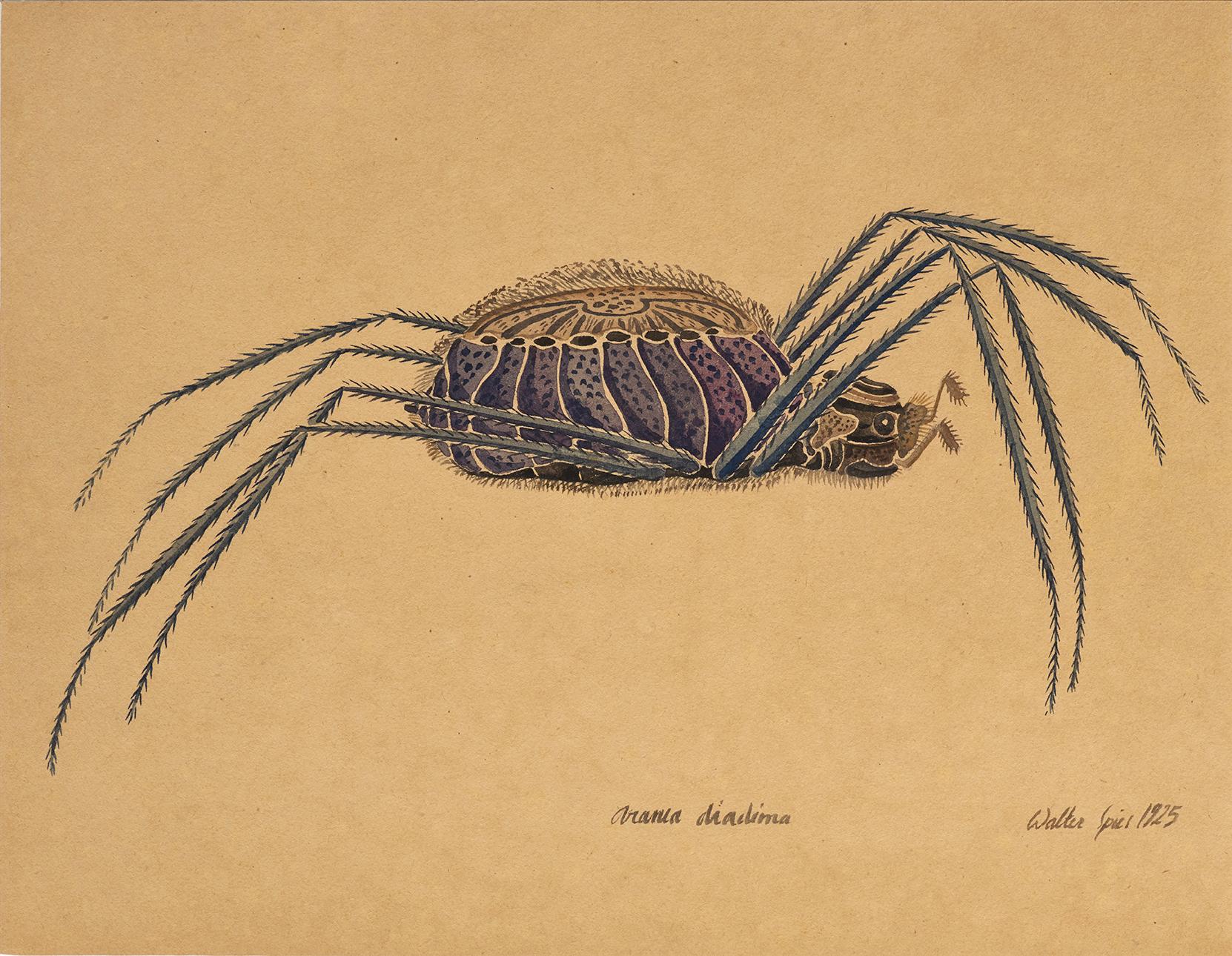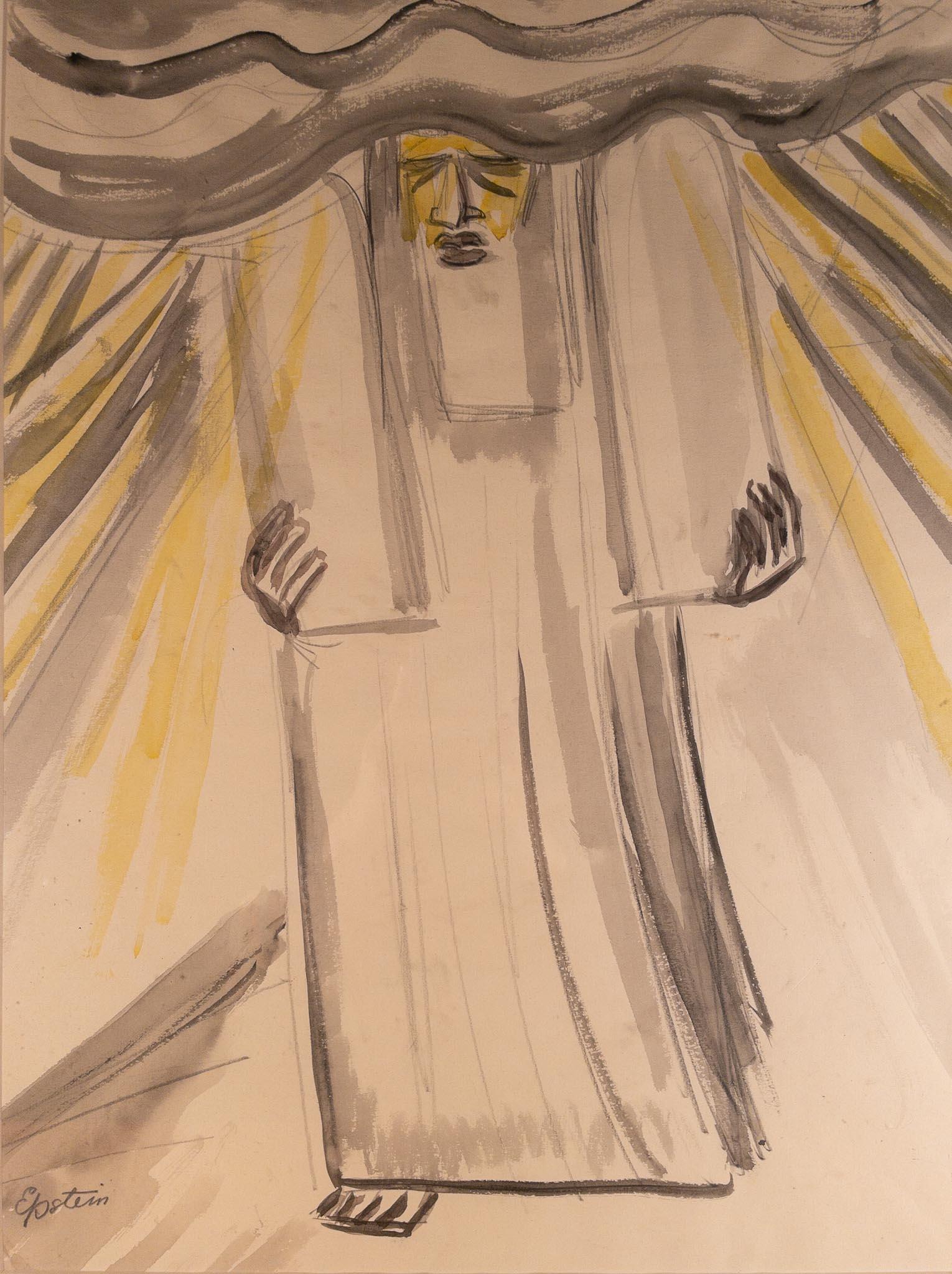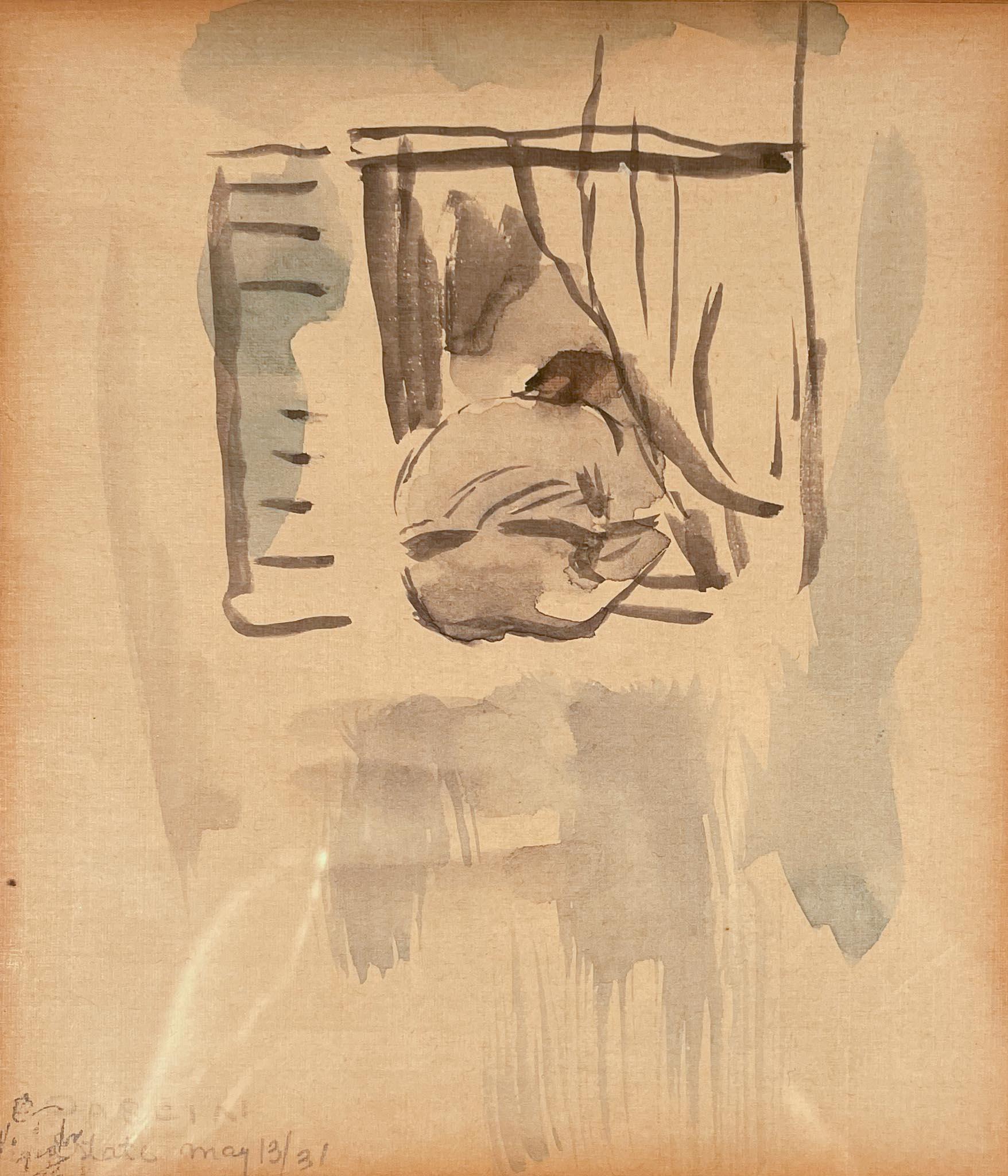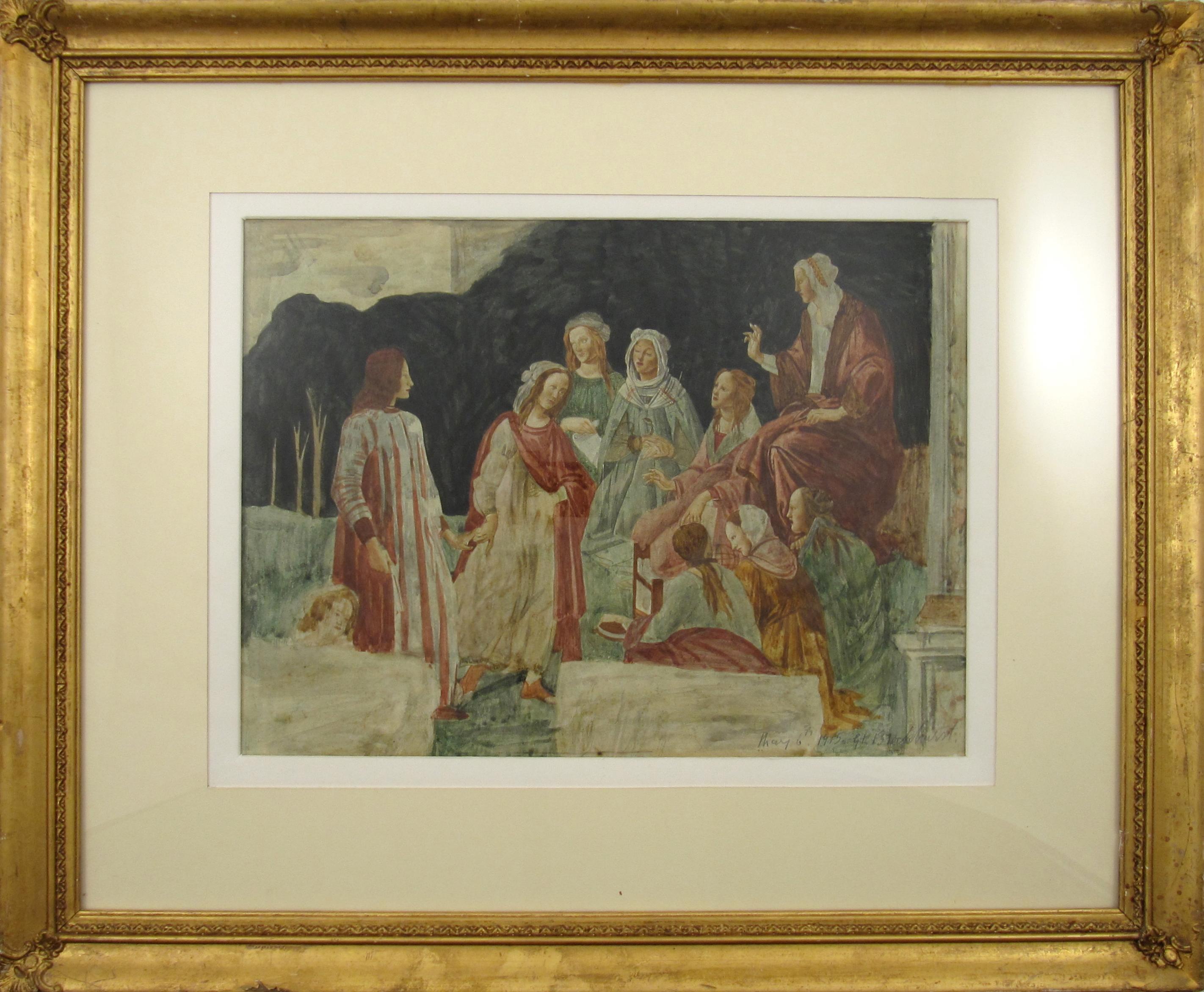Items Similar to UNTITLED (TWO MEN)
Want more images or videos?
Request additional images or videos from the seller
1 of 5
Pablo O'HigginsUNTITLED (TWO MEN)
About the Item
O'Higgins, Paul or Pablo (Mexican, born USA, 1904-1983). UNTITLED DRAWING (TWO MEN).
Watercolor on paper, not dated. Signed "Paul O'Higgins," lower right, so likely a work from his early days in Mexico, before he adopted the name "Pablo," by which he is best known, thus 1924 to early 1930s.
21 x 16 3/4 inches (sheet). In very good condition with a few very small nicks and losses at the sheet edge, bottom.
O'Higgins studied and worked with Diego Rivera, and was one of the founders of the Taller de Grafica Popular.
- Creator:Pablo O'Higgins (1904 - 1983, American)
- Dimensions:Height: 21 in (53.34 cm)Width: 18 in (45.72 cm)
- Medium:
- Period:
- Condition:In very good condition with a few very small nicks and losses at the sheet edge, bottom.
- Gallery Location:Portland, ME
- Reference Number:
About the Seller
5.0
Recognized Seller
These prestigious sellers are industry leaders and represent the highest echelon for item quality and design.
Platinum Seller
These expertly vetted sellers are 1stDibs' most experienced sellers and are rated highest by our customers.
Established in 1966
1stDibs seller since 2016
296 sales on 1stDibs
Typical response time: 2 hours
Associations
International Fine Print Dealers Association
- ShippingRetrieving quote...Ships From: Portland, ME
- Return PolicyA return for this item may be initiated within 10 days of delivery.
More From This SellerView All
- ACROBATSBy Reginald MarshLocated in Portland, MEMarsh, Reginald. ACROBATS. Ink, gouache, and pastel on paper, 1922. Signed, lower right. c. 18 1/2 x 14 1/2 inches; framed to 28 x 23 1/2 x 1 1/4 inches. In excellent condition.Category
1920s Figurative Drawings and Watercolors
MaterialsPastel, Ink, Gouache
- MEN IN BOWLER HATSBy Lester JohnsonLocated in Portland, MEJohnson, Lester (American, 1919-2010). MEN IN BOWLER HATS. Drawing, watercolor, wash, and pastel on paper, 1973. Signed, lower right. 26 1/2 x 40 1/2 inches...Category
1970s Figurative Drawings and Watercolors
MaterialsPastel, Watercolor
- UNTITLED (MOTHER NURSING BABY)By Leo PolitiLocated in Portland, MEPoliti, Leo. UNTITLED (WOMAN NURSING BABY). Gouache in colors, c. 1935. 6 7/8 x 4 1/2 inches, 175 x 114 mm.(sheet 12 x 10 inches). Signed. In excellent condition. Leo Politi (American, 1908-), best known as an illustrator of children's books, was also a painter and muralist. He studied at the Milan Art Institute. He was a member of the Painters & Sculptors of Los Angeles and exhibited at the Art Institute of Chicago, Pennsylvania Academy of Fine Arts and in Milan. He illustrated many books and this work may be an original book illustration.Category
1930s Figurative Drawings and Watercolors
MaterialsGouache
- HAPPY BIRTHDAY ANNEBy Michael HagueLocated in Portland, MEHague, Michael. HAPPY BIRTHDAY ANNE. Ink and Watercolor, not dated, but likely 1970s. Initialed "M.H." in ink within the image, and inscribed, within ...Category
1970s Figurative Drawings and Watercolors
MaterialsWatercolor
- ORTHOPHONIC EVENINGBy Walt KuhnLocated in Portland, MEKuhn, Walt (American, 1877-1949). ORTHOPHONIC EVENING. Drawing, ink and watercolor, 1928. Titled, signed and dated within the image, in ink, and further inscribed with the copyright...Category
1920s Figurative Drawings and Watercolors
MaterialsWatercolor
- NATIVE AMERICANS HUNTING - TWO DRAWINGS.By Cassilly AdamsLocated in Portland, MEAdams, Cassilly (American 1843-1921). NATIVE AMERICANS HUNTING - TWO DRAWINGS. Charcoal and watercolor, not dated. One signed within the matrix of the drawing, lower right. Each about 7 x 10 inches. Both with a tack hole top and and bottom, center, and with residue from an old mount, verso. One wih a 1/2 x 1/2 inch loss at the top right corner. The images fresh. One shows two hunters with grass head-dress disguises, crouched behind low grasses,each with a rifle, a killed deer between them, and a herd moving across the field on the far side of the grasses. The other depicts two hunters wearing animal-skin disguises, each with a rifle, crouched behind grasses, beyond which a small herd of bison grazes. The Pair: $1750.00 The following is from American Western Art...Category
Late 19th Century Figurative Drawings and Watercolors
MaterialsCharcoal, Watercolor
You May Also Like
- The Abduction of the Sabine Women , a Renaissance drawing by Biagio PupiniLocated in PARIS, FRThis vigorous drawing has long been attributed to Polidoro da Caravaggio: The Abduction of the Sabine Women is one of the scenes that Polidoro depicted between 1525 and 1527 on the façade of the Milesi Palazzo in Rome. However, the proximity to another drawing inspired by this same façade, kept at the Ecole des Beaux-Arts, and to other drawings inspired by Polidoro kept at the Musée du Louvre, leads us to propose an attribution to Biagio Pupini, a Bolognese artist whose life remains barely known, despite the abundant number of drawings attributed to him. 1. Biagio Pupini, a Bolognese artist in the light of the Roman Renaissance The early life of Biagio Pupini, an important figure of the first half of the Cinquecento in Bologna - Vasari mentions him several times - is still poorly known. Neither his date of birth (probably around 1490-1495) nor his training are known. He is said to have been a pupil of Francesco Francia (1450 - 1517) and his name appears for the first time in 1511 in a contract with the painter Bagnacavallo (c. 1484 - 1542) for the frescoes of a church in Faenza. He then collaborated with Girolamo da Carpi, at San Michele in Bosco and at the villa of Belriguardo. He must have gone to Rome for the first time with Bagnacavallo between 1511 and 1519. There he discovered the art of Raphael, with whom he might have worked, and that of Polidoro da Caravaggio. This first visit, and those that followed, were the occasion for an intense study of ancient and modern art, as illustrated by his abundant graphic production. Polidoro da Caravaggio had a particular influence on the technique adopted by Pupini. Executed on coloured paper, his drawings generally combine pen, brown ink and wash with abundant highlights of white gouache, as in the drawing presented here. 2. The Abduction of the Sabine Women Our drawing is an adaptation of a fresco painted between 1525 and 1527 by Polidoro da Caravaggio on the façade of the Milesi Palace in Rome. These painted façades were very famous from the moment they were painted and inspired many artists during their stay in Rome. These frescoes are now very deteriorated and difficult to see, as the palace is in a rather narrow street. The episode of the abduction of the Sabine women (which appears in the centre of the photo above) is a historical theme that goes back to the origins of Rome and is recounted both by Titus Livius (Ab Urbe condita I,13), by Ovid (Fasti III, 199-228) and by Plutarch (II, Romulus 14-19). After killing his twin brother Romus, Romulus populates the city of Rome by opening it up to refugees and brigands and finds himself with an excess of men. Because of their reputation, none of the inhabitants of the neighbouring cities want to give them their daughters in marriage. The Romans then decide to invite their Sabine neighbours to a great feast during which they slaughter the Sabines and kidnap their daughters. The engraving made by Giovanni Battista Gallestruzzi (1618 - 1677) around 1656-1658 gives us a good understanding of the Polidoro fresco, allowing us to see how Biagio Pupini reworked the scene to extract this dynamic group. With a remarkable economy of means, Biagio Pupini takes over the left-hand side of the fresco and depicts in a very dense space two main groups, each consisting of a Roman and a Sabine, completed by a group of three soldiers in the background (which seems to differ quite significantly from Polidoro's composition). The balance of the drawing is based on a very strongly structured composition. The drawing is organised around a median vertical axis, which runs along both the elbow of the kidnapped Sabine on the left and the foot of her captor, and the two main diagonals, reinforced by four secondary diagonals. This diamond-shaped structure creates an extremely dynamic space, in which centripetal movements (the legs of the Sabine on the right, the arm of the soldier on the back at the top right) and centrifugal movements (the arm of the kidnapper on the left and the legs of the Sabine he is carrying away, the arm of the Sabine on the right) oppose each other, giving the drawing the appearance of a whirlpool around a central point of support situated slightly to the left of the navel of the kidnapper on the right. 3. Polidoro da Caravaggio, and the decorations of Roman palaces Polidoro da Caravaggio was a paradoxical artist who entered Raphael's (1483 - 1520) workshop at a very young age, when he oversaw the Lodges in the Vatican. Most of his Roman work, which was the peak of his career, has disappeared, as he specialised in facade painting, and yet these paintings, which are eminently visible in urban spaces, have influenced generations of artists who copied them abundantly during their visits to Rome. Polidoro Caldara was born in Caravaggio around 1495-1500 (the birthplace of Michelangelo Merisi, known as Caravaggio, who was born there in 1571), some forty kilometres east of Milan. According to Vasari, he arrived as a mason on the Vatican's construction site and joined Raphael's workshop around 1517 (at the age of eighteen according to Vasari). This integration would have allowed Polidoro to work not only on the frescoes of the Lodges, but also on some of the frescoes of the Chambers, as well as on the flat of Cardinal Bibiena in the Vatican. After Raphael's death in 1520, Polidoro worked first with Perin del Vaga before joining forces with Maturino of Florence (1490 - 1528), whom he had also known in Raphael's workshop. Together they specialised in the painting of palace façades. They were to produce some forty façades decorated with grisaille paintings imitating antique bas-reliefs. The Sack of Rome in 1527, during which his friend Maturino was killed, led Polidoro to flee first to Naples (where he had already stayed in 1523), then to Messina. It was while he was preparing his return to the peninsula that he was murdered by one of his assistants, Tonno Calabrese, in 1543. In his Vite, Vasari celebrated Polidoro as the greatest façade decorator of his time, noting that "there is no flat, palace, garden or villa in Rome that does not contain a work by Polidoro". Polidoro's facade decorations, most of which have disappeared as they were displayed in the open air, constitute the most important lost chapter of Roman art of the Cinquecento. The few surviving drawings of the painter can, however, give an idea of the original appearance of his murals and show that he was an artist of remarkable and highly original genius. 4. The façade of the Milesi Palace Giovanni Antonio Milesi, who commissioned this palace, located not far from the Tiber, north of Piazza Navona, was a native of the Bergamo area, like Polidoro, with whom he maintained close friendly ties. Executed in the last years before the Sack of Rome, around 1526-1527, the decoration of Palazzo Milesi is considered Polidoro's greatest decorative success. An engraving by Ernesto Maccari made at the end of the nineteenth century allows us to understand the general balance of this façade, which was still well preserved at the time. The frescoes were not entirely monochrome, but alternated elements in chiaroscuro simulating marble bas-reliefs and those in ochre simulating bronze and gold vases...Category
16th Century Old Masters Figurative Drawings and Watercolors
MaterialsInk, Gouache, Pen
- Aranea diadima a study by Walter Spies, an artist living in Indonesia in the 30sLocated in PARIS, FRWalter Spies was one of the first Europeans to settle in Bali after a stay in Java. He greatly contributed to the discovery and popularization of Balinese...Category
1920s Art Deco Animal Drawings and Watercolors
MaterialsWatercolor
- Moses With the Ten CommandmentsBy Sir Jacob EpsteinLocated in New York, NYMoses With the Ten Commandments by Sir Jacob Epstein (1880-1959) Pencil and watercolor on paper 22 x 16 ⅝ inches unframed (55.88 x 42.24 cm) 28 ½ x 23 inches framed (72.39 x 58.42 cm) Signed on bottom left Description: In this figurative watercolor painting, Jacob Epstein depicts Moses holding two tablets, one in each arm, that are inscribed with the ten commandments. This is a visualization of the traditional biblical story in which Moses goes to Mount Sinai and has the ten commandments revealed to him by God which he inscribed onto two tablets and keeps in the Ark of the Covenant...Category
20th Century Post-Modern Figurative Drawings and Watercolors
MaterialsWatercolor, Pencil
- Figure Looking Out WindowBy Jules PascinLocated in New York, NYFigure Looking Out Window by Jules Pascin (1885-1930) Watercolor on paper 5 ¼ x 4 ½ inches unframed (13.335 x 11.43 cm) 13 ¾ x 10 ⅜ inches framed (34.925 x 27.002 cm) Signed and date...Category
20th Century Figurative Drawings and Watercolors
MaterialsWatercolor
- Gerald L. Brockhurst British 1890-1978, Botticelli ‘s Liberal Arts Aquarell 1915By Gerald Leslie BrockhurstLocated in Meinisberg, CHGerald Leslie Brockhurst (British/American, 1890-1978) In the Circle of the liberal Arts After Alessandro Botticelli's Fresco: ' A Young Man being introduced to the Seven Liberal Arts ' • Water colour on paper mounted behind old stained mount, this one then laid under a modern clean mount and presented in an antique glased...Category
1910s Pre-Raphaelite Figurative Drawings and Watercolors
MaterialsWatercolor, Cardboard
- 19th Century Watercolour Portrait Country Scene Milk Maids Farm SceneLocated in York, GBA 19th Century WATERCOLOUR depicting a charming British rural scene with Milk maids and children in a farmstead size of image approx 28 x 23 cm (11" by 9") oval overall size( 41 x 46...Category
19th Century English School Figurative Drawings and Watercolors
MaterialsWatercolor





